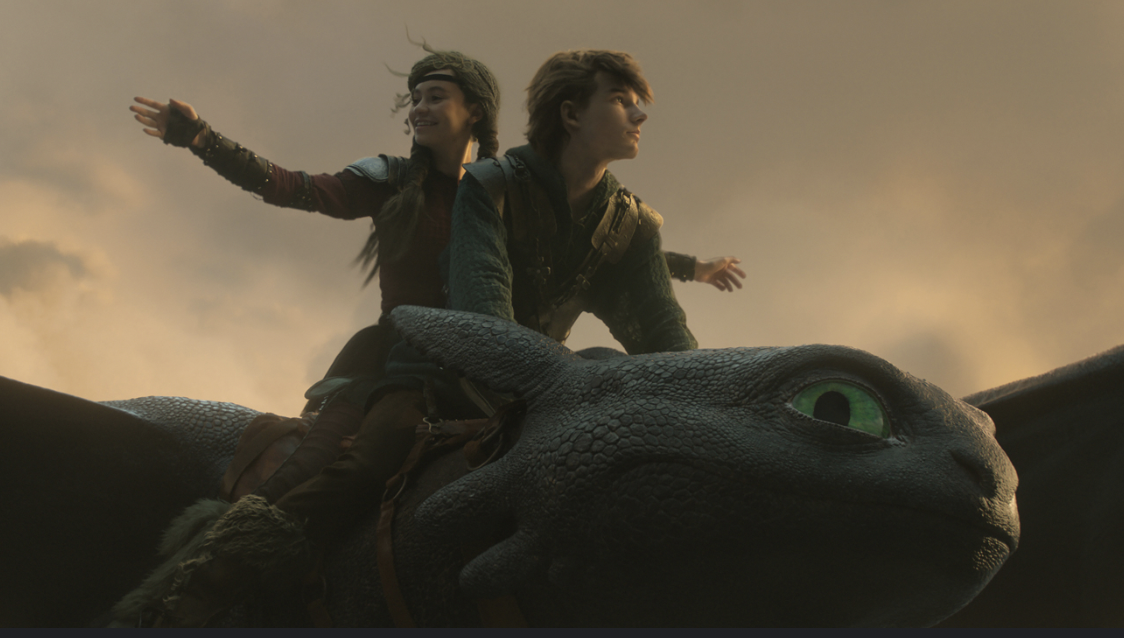The live action remake of How to Train Your Dragon features the familiar Irish landscape of the Causeway Coast, Giant's Causeway, Murlough Bay, and Dunseverick Castle; Ihinose Enebi saddles up in her review.
The live-action How to Train Your Dragon swoops in to retell a beloved story, breathing new life into its fiery lungs.
From the start, Hiccup (Mason Thames), is out of step with the world he was born into. Set in the village of Berk, where brute strength and dragon-slaying are glorified, Hiccup is a wiry kid with more curiosity than courage. His father, Stoick the Vast (Gerard Butler), is chieftain. Stoick is steadfast and shaped by a world that equates strength with slaughter and battle scars. His love for his son runs deep, but so does the building pressure he places on Hiccup.
When Hiccup injures a Night Fury, the most dangerous and feared dragon in his realm, he finally has the chance to prove himself as a Viking. But when he finds the creature trapped and terrified in the woods, he cannot deliver the final blow. Instead, he cuts ‘Toothless’ free. That small act of mercy sets everything else in motion.
Toothless and Hiccup’s connection unfolds without language, and through cautious steps and shared wonder, they unravel the myths Hiccup’s community was built on. Theirs is a quiet platonic love story; Hiccup teaches Toothless to trust a human and Toothless teaches Hiccup to trust himself.
Meanwhile, Astrid (Nico Parker), one of Berk’s fiercest young warriors, prides herself on discipline and strength. At first, she sees him as little more than a privileged boy, out of his depth in a world built for slayers. But when he introduces her to Toothless, she builds a reluctant trust. Can they convince the village to change?
Despite the high praise, this film is not without its flaws. There is a jarring moment where a character is described as coming from the “sun-baked coasts of Bláland.” The term is drawn from Old Norse sagas, medieval Icelandic and Scandinavian stories blending history, legend and myth.
In these texts, Bláland, literally “blue” or “black land”, referred to regions of Africa, and words like blámaðr were used to mark someone as dark-skinned or foreign, often in broad, exoticising strokes rather than as fully realised people. In the film, the phrasing lands awkwardly; it reduces a Black-coded character to a geographic cliché rather than giving them the nuance and presence that the rest of the story affords. In a movie that otherwise invests in careful world-building and layered characters, it feels unnecessary, a brief but lingering echo of outdated storytelling habits.
Visually and technically, the film invests heavily in creating a tactile, immersive world rather than simply translating the animated original into live action.
The production journey did have its challenges. The pre-production period coincided with the 2023 SAG-AFTRA strike, which delayed some initial preparations. Once underway, filming was primarily in Northern Ireland from January through May 2024, with production using Belfast’s Titanic Studios and Belfast Harbour Studios for major set builds. Outdoor natural locations such as Tollymore Forest Park, Dunseverick Castle, Murlough Bay and the Giant’s Causeway provided the rugged and dramatic landscapes of Berk. The production designer (Dominic Watkins), along with the art department, built full-scale Viking village sets in the backlots of Titanic Studios, and the cinematographer (Bill Pope) utilised the expansive natural coastline to give sweeping wide shots real weight.
The dragon designs strike a balance between myth and realism. The VFX supervisor (Christian Manz) worked closely with the writer and director (Dean DeBlois) to bring the animations to life. The dragons were rendered through a hybrid of practical puppetry, using on-set models to give actors real-life reference, and high-end VFX for flight and action sequences. DeBlois spoke on the challenges of redefining creatures originally animated: “We went too far a couple of times in exploring where Toothless could have come from”.
On the creative side, the project is significant in that Dean DeBlois, who co-wrote and co-directed the original trilogy, returned to write, direct and produce this reimagining. In interviews, he has admitted that he is not a fan of remakes and acknowledged that he sees “a lot of live-action remakes as being unnecessary”. His intention with this film was to deliver what he called a “love letter” to the fans and the world he built, while making use of live-action tools to deepen the original meaning.
DeBlois chose Northern Ireland in part because of its dramatic terrain and because the film-industry infrastructure was robust there. He describes how the team flew helicopters around Iceland, the Faroe Islands and the Isle of Skye to scout the ideal blend of “larger than life, and… ethereal” terrain before locking in Northern Ireland as the core location. Actor Nico Parker also mentioned how it was a “predominantly Belfast crew” who “welcomed [them] with open arms”.
The original composer (John Powell) returned to score the film, layering familiar melodic themes with new orchestral harmonies that swell under the rush of dragon wings and hum of village life. The sound design embraces scale, making it almost possible to feel the wind ripple through the theatre, grounding the fantasy in sensory reality.
Casting, too, finds a careful balance. Finding young actors to step into iconic roles can be risky, but Mason Thames and Nico Parker shoulder the emotional weight of Hiccup and Astrid. Gerard Butler reprises his animated role as Stoick the Vast, offering a satisfying through-line to the original trilogy.
At 125 minutes, the live-action adaptation stretches past the original animation’s 98 minutes, using the extra space for soaring flight sequences, richer world-building and moments of quiet reflection.
How to Train Your Dragon remains a triumph, building a world that visually honours the original films while expanding it into something new.
How to Train Your Dragon is available to rent online now.

